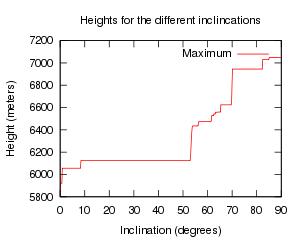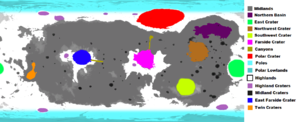Mun/hu
Mün,szintén ismert mint A Mün és néha úgy írva mint Mun, egy viszonylag nagyobb a hold amely a Kerbin körül kering. Úgy is gondolhatunk rá mint a mi Holdunk megfelelőjére. A szürke színével, különböző méretű krátereivel és 5029 métert felülmúló hegyeivel. A felszíni gyorsulás 1.63 m/s², közelítőleg 1/6-a és 8.18 m/s²-tel kevesebb mint a Kerbiné és közelítőleg annyi mint a Föld Holdjáé(1.624 m/s²). Lehetséges leszállni a Münre vagy felhasználni hintamanőverekhez [gravity assist] (gravitácós parittya) más testek eléréséhez mint a Minmus vagy a Kerbol körüli pályára, bár ezek a manőverek sok üzemanyagot spórolhatnak meg, de kevésbé pontosak - azonban mégis hasznosak megfelelő időzítéssel.
Az új játékosok jegyezzék meg hogy a Mün (mint a égitestek többsége a játékban) nem rendelkezik légkörrel. Ez azt jelenti, hogy az ejtőernyők nem használhatók a felszínre való leereszkedéskor!
Rendhagyó geológiai alakzatok találhatóak a Mün felszínén. Hogy megtartsuk az új játékosoknak a felfedezés örömét, nem közöljük ezek koordinátáit.
A szinkronpálya a Mün körül nem lehetséges, mivel az ehhez szükséges magasság 2 970,58 km, amely túl van a Mün hatássugarán [sphere of influence]. egy normális 25 km-es keringési pálya 800 m/s delta-v árán érhető el. A forgássebesség felével rendelkező fél-szinkron pálya lehetséges 1797.41 kilométeres magassággal.
Contents
Játékbeli leírás
| „ | The Mun, is a large satellite orbiting Kerbin. It is mostly grey in appearance, with craters of various sizes dotting its otherwise smooth surface. The Muns discovery is widely regarded as one of the more important breakthroughs of Kerbal evolution. Granted it didn’t happen all that long ago, but it’s still fair to say that Kerbals are wiser and more evolved now than they were back then. — Kerbal Astronomical Society |
” |
Terrain
The Mun's terrain is rough, grey, and scarred by craters. Its low-lying areas tend to be darker in color. The Mun also features canyons which can be hundreds of meters deep and a few kilometers long.
The Mun's highest points reach a maximum altitude of more than 7061 m near the south pole at 152.33° W and 82.52° S. This altitude permits 10× warp, allowing crashes with terrain while being in a seemingly stable orbit. Its lowest point, below -247 m, is on the northern hemisphere south-west of the large northern crater at 76.63° W and 35.32° N.
When terrain scatter is activated in the graphics settings, the Mun has rocks scattered on its surface. Like all terrain scatters, these rocks are strictly cosmetic and do not collide with ships or Kerbals.
As of 0.21 the Mun is peppered with procedural impact craters making Mun landing more difficult. Previously the lowest point with an altitude of 0 m was on the east side of a large crater, at 35.42° E, 8.27° N.
The Hell Kraken has been encountered on the mün, with objects being thrown out of kerbin's sphere of influence upon re-loading the vehicle.
The Mun also has several hidden surprises for explorers to find:
- There are three large stone arches. Due to their size they can be spotted easily from a low (<10km) orbit near the equator.
- There is a memorial honoring Neil Armstrong, the first man on the moon. It can be found inside one of the largest craters, near the south wall. It is at nearly the same coordinates where Apollo 11 first landed on the moon. It appears as a tiny white dot from low orbit.
- There are three monoliths ("Munoliths"). These are very hard to find because of their small size. One is underground, and two are floating inside of two extremely deep pits that go almost straight down.
- There are several other secrets on the Mun for the dedicated observer. Look around!
Biomes
Currently Mun is one of only three celestial bodies, alongside Kerbin and Minmus, which has multiple biomes in or over which science experiments deliver different results. It has even more biomes than Kerbin. Each of the large craters is an individual biome. Then there are midlands- and highlands, which both return different results when inside/over one of the minor craters. The polar regions also have three different biomes. With the biomes the major craters have somewhat official names, although the names appear to be very generic.The complete list of Mun biomes is:
- Midlands
- Midland Craters
- Highlands
- Highland Craters
- Canyons
- Northern Basin
- East Crater
- Northwest Crater
- Southwest Crater
- Farside Crater
- Twin Craters
- East Farside Craters
- Polar Crater
- Poles
- Polar Lowlands
Observation from Kerbin
The Mun's orbit keeps it directly above Kerbin's equator. Because the Mun is tidally locked to Kerbin with a perfectly circular, non-inclined orbit, exactly 50% of the Mun's surface (excluding areas on the edge obscured by the Mun's mountains) is ever visible from Kerbin.
Due to the Mun's non-inclined orbit, solar eclipses occur every time the Mun goes between the Sun and Kerbin. Due to graphic engine limitations, these solar eclipses currently do not make the sky black, or darken the land. However, solar panels will become blocked by the Mun in an eclipse and become useless for a short period of time.
Observation of Kerbin
Because Mun is tidally locked to Kerbin, Kerbin is only visible from 50% of the Mun's surface, and Kerbin never sets or rises as seen from the Mun. The Mun longitude for which Kerbin remains directly above in the sky (at the zenith) is about 47 degrees east. The Mun's equator is coplanar with Kerbin's, so any location on the Mun's equator that faces Kerbin will also face Kerbin's equator. Kerbin is not tidally locked to the Mun, so any point on the Mun where Kerbin is not obscured by the Mun's landscape will be able to observe every point on Kerbin as Kerbin rotates. Kerbin's synodic rotational period with the Mun is 25617.909 seconds, or 1.18323 Kerbin solar days.
Science
Although the science-multipliers of Mun's surface and orbit are quite low compared to that of other planets and moons, Mun is comparably easy to reach and has a very large number of biomes which all yield different science results. This makes it - together with Minmus - the main source of science points during the midgame.
Reference Frames
Gallery
- Error creating thumbnail: File missing
Four kerbals manning a Mun base
Trivia
- Prior to verzió 0.14.2, the tallest points on the munar surface were no higher than roughly 600m.
- Mun was Kerbin's, and indeed the game's, very first moon.
- After its implementation, many fans began calling the body Mün, pronounced the same as "moon", believing the original spelling to be a mistake. However, several of the game's developers have been heard referring to it as Mun, pronounced "muhn". In the "Surface of the Mün" title screen, a crashed lander resembling a Kerbal X has the words "Mün or Bust" scrawled on the side. Both spellings are generally accepted, however the spelling in-game is Mun.
- Mun's orbit is perfectly circular and has zero orbital inclination. Such an orbit in reality would be very unlikely since this would require precise positioning of any dust/bodies that created it during the planetary system's formation, as well as the absence of a central star or other planets.
- This was likely done to make it easier to reach for new players.
- Before introduction of procedural terrain the Mun's highest point was within 45° latitude of the equator, had an altitude of 2967 m and was located at 129.64° W, 0.97° N, on the north side of a canyon which was on the east edge of a large crater.
Megjegyzések















